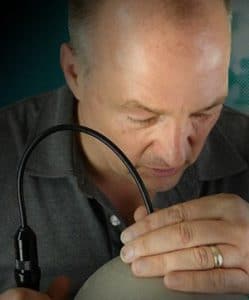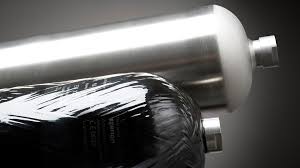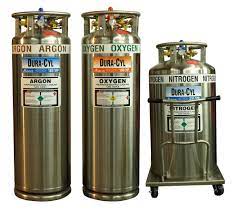
Cylinder Inspection Training: Why a Maintained Cylinder Is a Happy Cylinder
Uncover the importance of gas cylinder inspections and training. Dive deep into ensuring safety, boosting efficiency, and prolonging cylinder life.
Galvanic Coupling and Composite Cylinders
Proper inspections for composite cylinders used around water
Don Kinney – Cylinder Training Services
I enjoy talking with people because I learn so many things from the most unexpected conversations. I had the great experience at a recent trade show to speak with John. I won’t mention the last name because I don’t know if he wants to share. But, John was very helpful and gave me a 15-minute education on Corrosion. Not the corrosion most of us are familiar with, involving steel and aluminum cylinders, but corrosion involving composite cylinders. John has a background in testing composite cylinders. We were discussing the introduction of composite cylinders into the diving world and he had reservations. Being the novice, I asked why, since carbon fibers won’t have an issue of corrosion. He very quickly corrected me and mentioned the term “Galvanic Coupling.”
I took the information from John and conducted some more research. I learned a lot that I would never have guessed. I located an article on Galvanic corrosion written by the University of Southern California[1]. I learned that carbon is on the opposite end of the galvanic series in relation to aluminum. Hence if carbon is in direct contact with the aluminum it can cause the aluminum to corrode at a faster rate. I also learned that there are five factors that must be present for composite to metal corrosion to occur:
We teach during our inspection course that we need three components for corrosion to begin on a steel or aluminum cylinder; oxygen, moisture and the metal. The corrosion of metal attached to carbon fiber is similar but with a potentially accelerated effect caused by the fact that each of these components is on the opposite spectrum of the galvanic series. With the addition of moisture (electrolyte) and no barrier between the components, the metal can corrode at an accelerated rate when in direct contact with a carbon fiber.
The concern John mentioned regarding composite cylinders was that corrosion can occur between the metal liners and the composite material. Corrosion can begin if a cylinder is in an electrolytic (water) environment. The aluminum acts as an Anode and the Carbon Fiber acts as a cathode. This in turn can accelerate corrosion of the metal and weaken the structure of the cylinder.
When inspecting a steel or aluminum high pressure cylinder, you can check the structure of the cylinder both internally and externally, nothing is hidden from the inspector. However, when you layer a cylinder, such as in the case with a composite cylinder you cannot inspect between the layers. A concern is raised as to what is occurring beyond the scope of the VISUAL inspection.
A composite cylinder has four layers; the metal shell used to create the size and shape and allow a valve to be inserted, the carbon fiber wrap, the fiberglass to act as a barrier and finally the epoxy coating. If the metal liner corrodes, and the liner is exposed to the carbon fiber, corrosion can accelerate. However, the corrosion will occur between the liner and carbon fiber out of view of the visual inspection. If that corrosion happens to weaken the neck area, where the valve is inserted, it could potentially weaken the cylinder and the cylinder could rupture unexpectedly.
The issue with composite cylinders involved with diving is that they are exposed to an electrolyte solution (water). Water is a factor in all galvanic corrosion because it has the potential of increasing the rate of corrosion. A 3.5% solution of salt water is known to increase the rate of corrosion of metal. If you have a composite cylinder, with no barrier between the fibers and the metal, in a salt water environment, the metal can corrode at an accelerated rate.
In order to prevent contact with the carbon fibers the metal liner of the cylinder is coated with a non-conductive product. With no contact between the fibers and the metal, galvanic coupling can be prevented. NASA conducted a study in 1983[2] which proved the benefit of coating the metal shell. However, if the cylinder is damaged, and the metal encounters the carbon fiber; the corrosion will accelerate in the presence of an electrolyte.
The manufacturers have also coated the exterior of the cylinder with an epoxy layer. The layer is designed to protect the fibers around the cylinder. This epoxy layer can also help to repel any moisture which encounters the cylinder. However, if this coating is breached, then the metal and carbon fiber may be exposed to an electrolyte solution.
Some composite cylinders have been approved for use in water environments. The cylinders have been properly manufactured to resist the effects of Galvanic coupling. However, with everyday use, the cylinder may become damaged and accelerated corrosion may occur. The cylinder should not be inspected by an unaware technician.
With the introduction of composite cylinders into the diving world, the cylinder inspector needs to be properly trained to look for these types of issues. They must inspect the interior of the cylinder for damage which may cause the metal to encounter the fibers. They must inspect the exterior of the cylinder to ensure that damage has not occurred which not only damages the fibers but could create a situation where the fibers could contact the bare metal. The inspector must take extra care and conduct a thorough inspection of the composite cylinder being aware of the issue of galvanic coupling.
As technology progresses new materials are going to be introduced that have great benefits such as carbon fiber cylinders. They are lighter yet stronger than solid metals. However, basic safety practices cannot be ignored and steps must be taken to ensure the safety of all cylinders; steel, aluminum and composite.
[1] Eric Bosze and Steven Nutt
Gill Foundation Composites Center
University of Southern California June 2008
[2] NASA technical paper 2236

I enjoy continuing to build the business based on safety since 1999. CTS focuses on the inspection of high pressure cylinders, the maintaining of the valves and basic maintenance of high pressure compressor systems. CTS stays current in techniques and tools to train both the new and novice employee. We publish articles, update training tools and have created an APP to assist during the inspection process.
#cylinder #safety #hazmat #training #cylinderinspectiontraining #cylindex

Uncover the importance of gas cylinder inspections and training. Dive deep into ensuring safety, boosting efficiency, and prolonging cylinder life.

Is your composite cylinder showing signs of wear? Discover when to seek a professional repair service in our comprehensive guide.

29 CFR 1910.101 intro Handling cryogenic cylinders involves working with extremely low-temperature gases that pose unique safety risks. To ensure the safe handling, storage, and transportation of these hazardous materials,

Introduction Firefighters encounter many risks while on duty, including hazardous materials and high pressure bottles. High pressure bottles are used for a variety of purposes in firefighting, including powering hydraulic